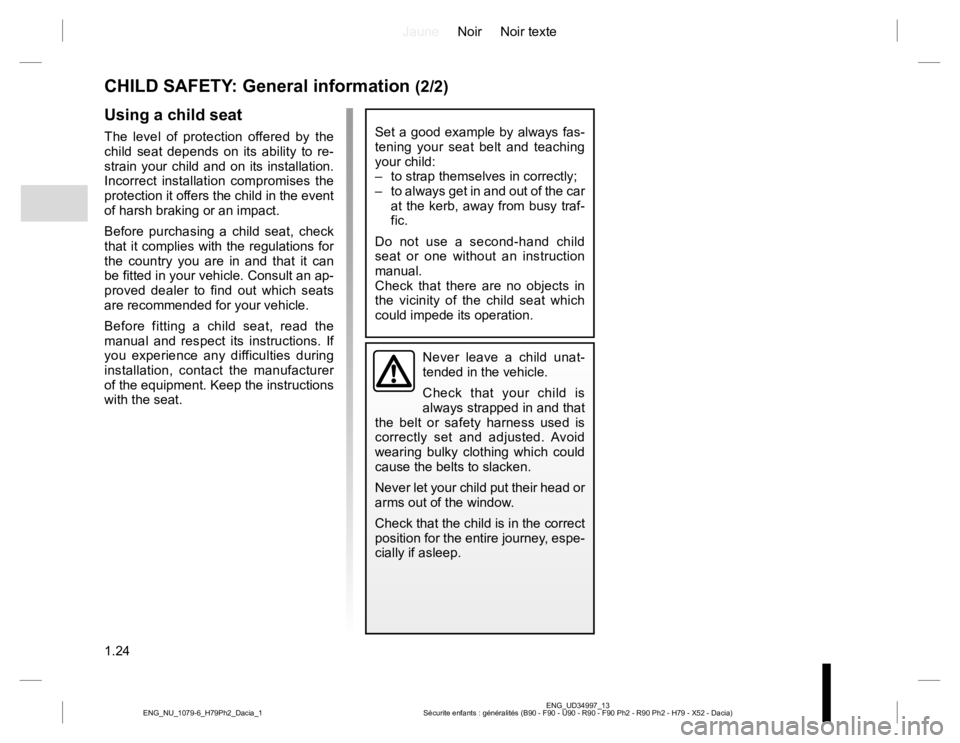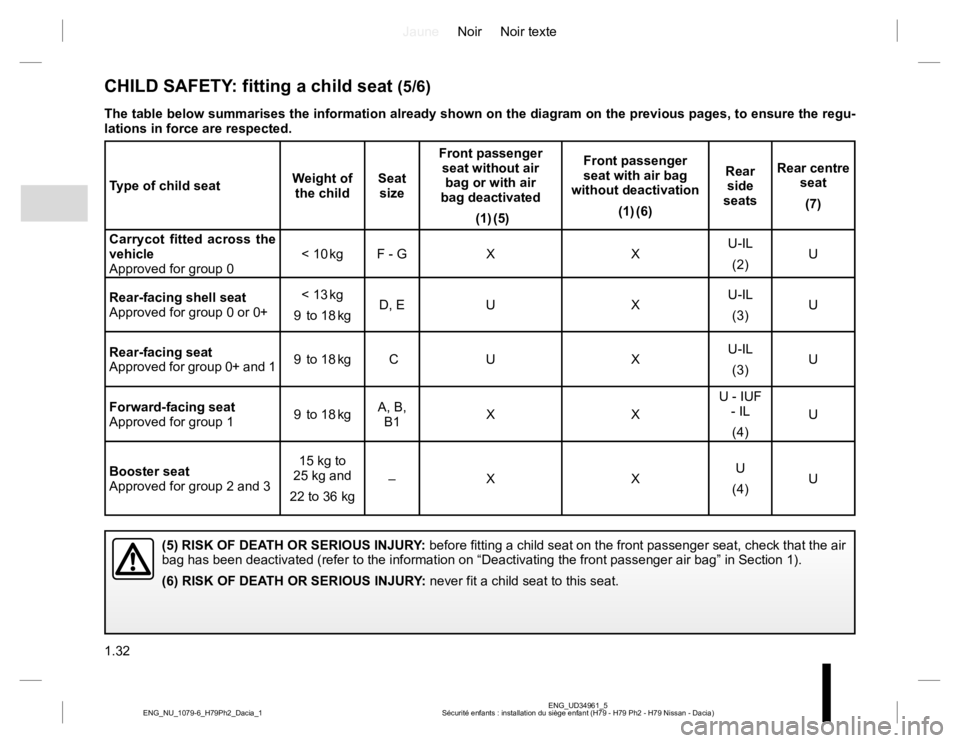2015 RENAULT DUSTER ESP
[x] Cancel search: ESPPage 6 of 254

JauneNoir Noir texte
1.2
ENG_UD39222_2
Clé / télécommande à radiofréquence : généralités (X52 - H79 Ph2 - Renault) ENG_NU_1079-6_H79Ph2_Dacia_1
KEYS, RADIO FREQUENCY REMOTE CONTROL: general information (1/2)
Radio frequency remote
control B or C
2 Locks all the opening elements.
3 Unlocks all the opening elements.
Driver’s responsibility
Never leave an animal, child or adult who is not self-sufficient alone in
your vehicle, even for a short time.
They may pose a risk to themselves or to others by starting the engine, activating
equipment such as the electric windows or locking the doors, for example.
Also, in hot and/or sunny weather, please remember that the temperature inside
the passenger compartment increases very quickly.
RISK OF DEATH OR SERIOUS INJURY.
Key A
1 Coded key for ignition switch, doors
and fuel filler cap.
BA
3
2
1
1
The key must not be used for any
function other than those described
in the handbook (removing the cap
from a bottle, etc.).
3
2
4
C
4 Remote engine start-up.
1
Page 8 of 254

JauneNoir Noir texte
1.4
ENG_UD32107_1
Télécommande à radiofréquence : utilisation (H79 Ph2 - H79 Nissan - Dacia) ENG_NU_1079-6_H79Ph2_Dacia_1
RADIO FREQUENCY REMOTE CONTROL: use
Locking the doors
Press locking button 1.
The hazard warning lights and side in-
dicator lights flash twice to indicate
that the doors have locked.
If a door or the tailgate is open or not
properly shut, the doors and tailgate
lock then quickly unlock and the hazard
warning lights and side indicator lights
do not flash.
Unlocking the doors
Press unlocking button 2.
The hazard warning lights and side in-
dicator lights flash once to indicate that
the doors have unlocked.
1
2
The key must not be used for any
function other than those described
in the handbook (removing the cap
from a bottle, etc.).
Driver’s responsibility
Never leave your vehi-
cle with the key inside and
never leave a child (or a
pet) unsupervised, even for a short
while.
They may pose a risk to themselves
or to others by starting the engine,
activating equipment such as the
electric windows or by locking the
doors.
Risk of serious injury.
If the vehicle has been unlocked
but neither the doors or tailgate are
open, it locks again automatically
after two minutes.
Page 9 of 254

JauneNoir Noir texte
1.5
ENG_UD39214_2
Verrouillage et déverrouillage des portes (H79 - H79 Ph2 - Dacia) ENG_NU_1079-6_H79Ph2_Dacia_1
LOCKING AND UNLOCKING THE DOORS (1/3)
Manual locking
From the outside
Unlock the doors using the remote con-
trol (refer to information on the “Radio
frequency remote control: use” in
Section 1) or using the key in one of the
door locks.
Depending on the vehicle, the key locks
and unlocks the driver’s door or all four
doors.
From the inside
(depending on vehicle)
Push in button 1 to lock and lift button 1
to unlock.
Child safety
To make it impossible for the rear doors
to be opened from the inside, move
lever 2 on each door and check from
the inside that the doors are securely
locked.
12
Never leave your vehicle
with the key or remote con-
trol inside.
Driver’s responsibility
If you decide to keep the
doors locked when you are
driving, remember that it
may be more difficult for those as-
sisting you to gain access to the
passenger compartment in the
event of an emergency.
Page 10 of 254

JauneNoir Noir texte
1.6
ENG_UD39214_2
Verrouillage et déverrouillage des portes (H79 - H79 Ph2 - Dacia) ENG_NU_1079-6_H79Ph2_Dacia_1
LOCKING AND UNLOCKING THE DOORS (2/3)
Electric central locking
Depending on the vehicle, it can be
used to simultaneously lock or unlock
the four doors and the boot. Lock or
unlock the doors by pressing switch 3.
The front door mechanism cannot be
locked if the door is open.
Driver’s responsibility
If you decide to keep the
doors locked when you are
driving, remember that it
may be more difficult for those as-
sisting you to gain access to the
passenger compartment in the
event of an emergency.
33
Never leave your vehicle
with the key or remote con-
trol inside.
Page 14 of 254

JauneNoir Noir texte
1.10
ENG_UD33620_2
Ouverture et fermeture des portes (H79 - H79 Ph2 - H79 Nissan - Dacia) ENG_NU_1079-6_H79Ph2_Dacia_1
OPENING AND CLOSING THE DOORS (2/2)
Driver’s responsibility
when parking or stopping
the vehicle
Never leave an animal,
child or adult who is not self-suffi-
cient alone on your vehicle, even for
a short time.
They may pose a risk to themselves
or to others by starting the engine,
activating equipment such as the
electric windows or by locking the
doors.
Also, in hot and/or sunny weather,
please remember that the tempera-
ture inside the passenger compart-
ment increases very quickly.
RISK OF DEATH OR SERIOUS
INJURY.Lights-on reminder buzzer
If you have left the lights on after switch-
ing off the ignition, a warning buzzer will
sound when a front door is opened (to
prevent the battery from discharging,
etc.).
Door/tailgate open buzzer
Depending on the vehicle, this alarm is
fitted to the driver’s side door or on all
opening elements.
With the vehicle at a standstill, a warn-
ing light
2 will come on if a door or the
boot is open or not properly closed.
While driving, as soon as the vehicle
reaches 12 mph (20 km/h), a warning
light
2 comes on with an audio beep.
Special note
Depending on the vehicle, accessories
(e.g. radio) stop working either when
the engine is switched off or when the
driver’s door is opened or when the
doors are locked.
Page 27 of 254

JauneNoir Noir texte
1.23
ENG_UD34997_13
Sécurite enfants : généralités (B90 - F90 - U90 - R90 - F90 Ph2 - R90 Ph2 - H79 - X52 - Dacia) ENG_NU_1079-6_H79Ph2_Dacia_1
CHILD SAFETY: General information (1/2)
Carrying children
Children, and adults, must be correctly
seated and strapped in for all journeys.
The children being carried in your vehi-
cle are your responsibility.
A child is not a miniature adult. Children
are at risk of specific injuries as their
muscles and bones have not yet fin-
ished growing. The seat belt alone
would not provide suitable protection.
Use an approved child seat and ensure
you use it correctly.
A collision at 30 mph
(50 km/h) is the same
as falling a distance of
10 metres. Transporting a
child without a restraint is the equi-
valent of allowing him or her to play
on a fourthfloor balcony without rail-
ings.
Never travel with a child held in your
arms. In the event of an accident,
you will not be able to keep hold of
the child, even if you yourself are
wearing a seat belt.
If your vehicle has been involved in
a road accident, replace the child
seat and have the seat belts and
ISOFIX fittings checked.
Never leave a child unat-
tended in the vehicle.
Check that your child is
always strapped in and that
the belt or safety harness used is
correctly set and adjusted. Avoid
wearing bulky clothing which could
cause the belts to slacken.
Never let your child put their head or
arms out of the window.
Check that the child is in the correct
position for the entire journey, espe-
cially if asleep.
To prevent the doors being
opened, use the childproof
locks (refer to the informa-
tion on “Locking/unlocking
the doors” in Section 1).
Page 28 of 254

JauneNoir Noir texte
1.24
ENG_UD34997_13
Sécurite enfants : généralités (B90 - F90 - U90 - R90 - F90 Ph2 - R90 Ph2 - H79 - X52 - Dacia) ENG_NU_1079-6_H79Ph2_Dacia_1
CHILD SAFETY: General information (2/2)
Using a child seat
The level of protection offered by the
child seat depends on its ability to re-
strain your child and on its installation.
Incorrect installation compromises the
protection it offers the child in the event
of harsh braking or an impact.
Before purchasing a child seat, check
that it complies with the regulations for
the country you are in and that it can
be fitted in your vehicle. Consult an ap-
proved dealer to find out which seats
are recommended for your vehicle.
Before fitting a child seat, read the
manual and respect its instructions. If
you experience any difficulties during
installation, contact the manufacturer
of the equipment. Keep the instructions
with the seat.Set a good example by always fas-
tening your seat belt and teaching
your child:
– to strap themselves in correctly;
– to always get in and out of the car
at the kerb, away from busy traf-
fic.
Do not use a second-hand child
seat or one without an instruction
manual.
Check that there are no objects in
the vicinity of the child seat which
could impede its operation.
Never leave a child unat-
tended in the vehicle.
Check that your child is
always strapped in and that
the belt or safety harness used is
correctly set and adjusted. Avoid
wearing bulky clothing which could
cause the belts to slacken.
Never let your child put their head or
arms out of the window.
Check that the child is in the correct
position for the entire journey, espe-
cially if asleep.
Page 36 of 254

JauneNoir Noir texte
1.32
ENG_UD34961_5
Sécurité enfants : installation du siège enfant (H79 - H79 Ph2 - H79 Nissan - Dacia) ENG_NU_1079-6_H79Ph2_Dacia_1
CHILD SAFETY: fitting a child seat (5/6)
(5) RISK OF DEATH OR SERIOUS INJURY: before fitting a child seat on the front passenger seat, check that the air
bag has been deactivated (refer to the information on “Deactivating the front passenger air bag” in Section 1).
(6) RISK OF DEATH OR SERIOUS INJURY: never fit a child seat to this seat.
The table below summarises the information already shown on the diagram on the previous pages, to ensure the regu-
lations in force are respected.
Type of child seatWeight of
the childSeat
sizeFront passenger
seat without air
bag or with air
bag deactivated
(1) (5)Front passenger
seat with air bag
without deactivation
(1) (6)Rear
side
seatsRear centre
seat
(7)
Carrycot fitted across the
vehicle
Approved for group 0< 10 kg F - G X XU-IL
(2)U
Rear-facing shell seat
Approved for group 0 or 0+ < 13 kg
9 to 18 kgD, E U XU-IL
(3)U
Rear-facing seat
Approved for group 0+ and 19 to 18 kg C U XU-IL
(3)U
Forward-facing seat
Approved for group 19 to 18 kgA, B,
B1XXU - IUF
- IL
(4)U
Booster seat
Approved for group 2 and 315 kg to
25 kg and
22 to 36 kg–X XU
(4)U